Fig. 4

Map of the residual CCF flux during the transit of KELT-9 b. The observations of two nights are binned by 2 in phase. The 1st and 4th contacts are traced with the horizontal dashed white lines; the 0 km s−1 and ± v sin i* are traced with vertical dashed white lines. Top panel: local stellar spectrum tracing the spin-orbit misalignment through the Rossiter-McLaughlin effect. The solid black line shows our best fit. The exoplanet transmission CCF, that has a slanted shape following the orbital velocity (dashed black line), traces the metal detections by Hoeijmakers et al. (2018, 2019). Bottom panel: residual CCF flux after the removal of the local stellar and of the planetary atmosphere spectra. The residuals are dominated by the stellar pulsations, whose strengths are 10 × lower than the local stellar signal (see the color scale). The pulsations are due to pressure-mode in a δ Scuti-type star.
Current usage metrics show cumulative count of Article Views (full-text article views including HTML views, PDF and ePub downloads, according to the available data) and Abstracts Views on Vision4Press platform.
Data correspond to usage on the plateform after 2015. The current usage metrics is available 48-96 hours after online publication and is updated daily on week days.
Initial download of the metrics may take a while.


